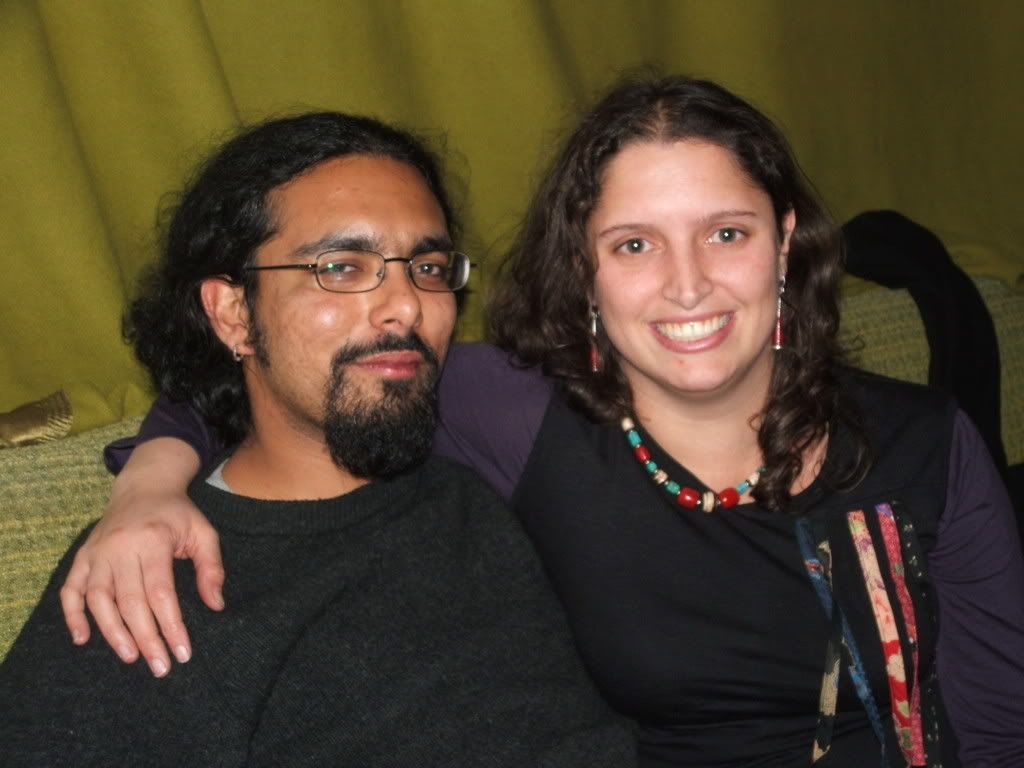Firenze (Florence)
However, before we could get there from Barcelona, there were a few little obstacles. Well, one major one, really - the French Railway Workers' Strike. Thanks, President Sarkozy. To get to Italy from Spain by rail, we had to go through France, and of course, there weren't any lines running in France! So, we got our abominably expensive train reservations mostly refunded, and bought even more abominably expensive plane tickets to Florence. Not only that, our Couchsurfing host had to pull out at the last minute, so we frantically booked a hostel, which actually turned out really well, as we met some really nice people, including Linda who ran the place and even took us out for coffee on our last day there.
Oh no! We need a picture before people fall asleep! Florence is known for Michaelangelo's David. However, we couldn't get a picture of the real one (for reasons we'll go into in a minute), so here's just one of the many imitations in the city, this one in the Piazza della Signoria:
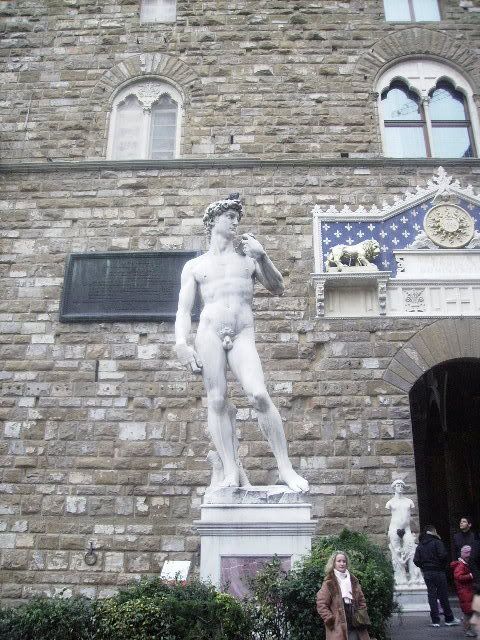
Our expectations of Florence were set high by Eva's dad Rai, who encouraged us to go there over somewhere like Rome or Pisa, saying that it was one of the most breathtaking and interesting cities in Europe, due to the sheer amount of beautiful art and architecture concentrated in the one place. He also warned us that we might become resentful at having to pay a lot to see everything. The Florentians have somewhat deviously separated all their works of note into different locations, and with entry between 6 and 10 euros a pop, it certainly did dampen our enthusiasm after a while. Having said that, we agree that there is something amazing about being surrounded by so much beauty and history, and the evidence of such great skill, ideas, and imagination of these long-dead artists.
Our first stop was the real David, in the Academia Gallery. However, another irritating aspect of the museums and galleries in Florence is that you can't take pictures, not even without a flash, therefore it's obviously not about preserving the works of art, but about making extra money from selling overpriced prints, books, etc. Shayne did manage to get the odd sneaky photo here, but a lot of the classics escaped the camera. These are some of the things we did capture:
The Duomo (Santa Maria del Fiore)

Another enormous cathedral (we're never going to be able to look at St Paul's or Patrick's in the same way ever again...), famous for its adjacent Baptistery:
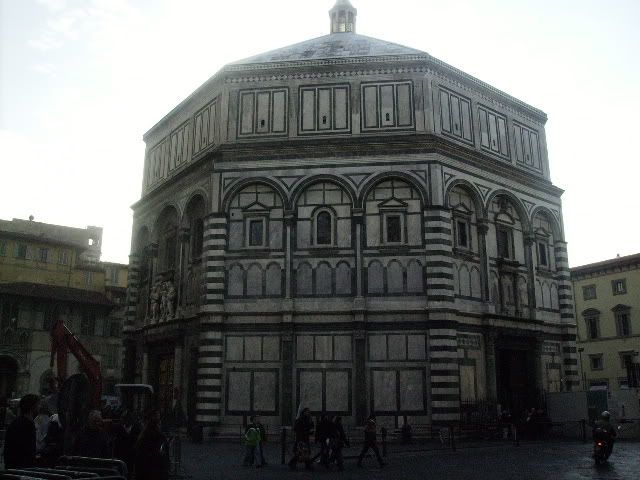
...and one of its famous doors, the Door of Paradise, complete with milling tourists and persistent beggars who follow you around when you don't give them enough change, yelling "Excuse me, mister!":
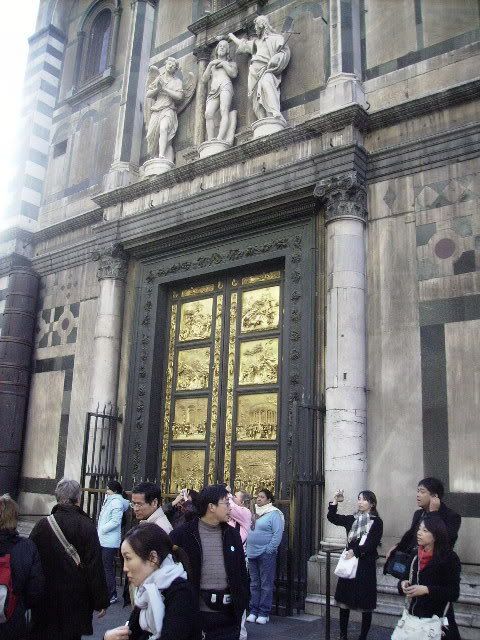
and bell-tower:
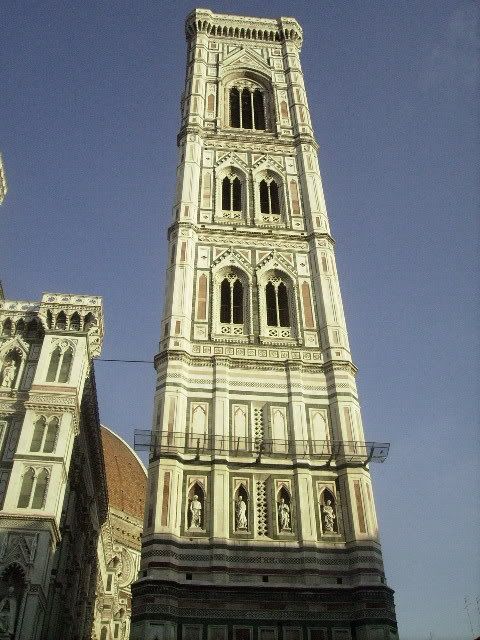
Its interior (free to enter, therefore free to photograph), including the gorgeous ceiling of the dome:
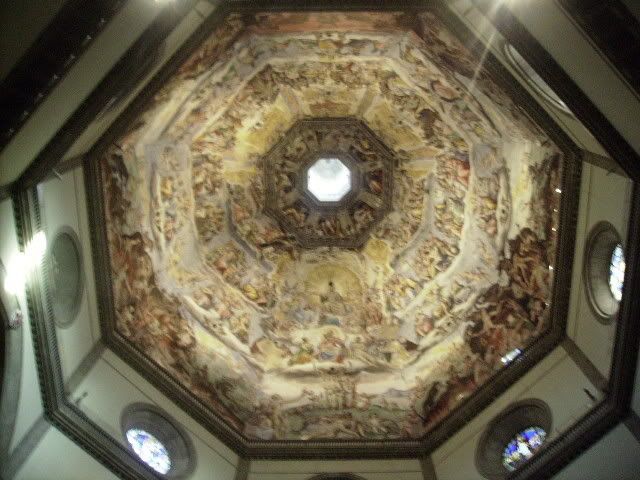
The Uffizi
This is one of Florence's most famous galleries. It's vast, so much so that by the time you get out, you're absolutely exhausted. Furthermore, the day we went, a lot of their collection wasn't even there - either away on international exhibitions, or being refurbished. Thus, we missed the Da Vinci drawings collection, which Eva saw in 1995 in Melbourne but which we were both hanging out to see. The other problem with the Uffizi, in Shayne's opinion, is that there's a lot of very mediocre stuff, particularly the religious paintings. The stunning Boticelli collection is tucked away between rooms full of the former, and of course there's the whole "no photo" policy. Shayne is resourceful, however, and snapped this quick one of some startled Roman sculptures:
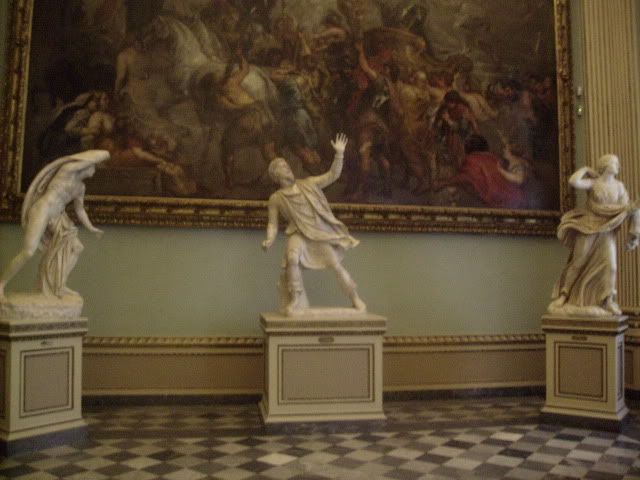
The other thing the Uffizi is full of is authoritarian officials, who sit there doing nothing until they admonish you for something. Shayne had a bit of fun with one of them: he was wandering around the main hall whistling the theme from the Godfather (probably not the wisest tune to be whistling, even quietly), and one of the guides snapped "Signor! No!" Shayne looked at her and played dumb, saying, "Oh, I'm sorry, I don't speak Italian." He watched her get more and more frustrated, trying to explain that he was not to whistle in the Uffizi. It was very fun watching her go red-faced with apoplexy.
On later days we also went into the Medici Chapels, where the Medicis spared no expense to celebrate the power of their dynasty and demonstrate their great wealth and influence, with semi-precious stones inlaid in marble all over the place (floors, walls, etc) and the Michelangelo sculptures in the crypts.
Two places we have plenty of photos of were those we deemed the best value for money, because one was free and the other we somehow managed to get into for half price...there is a big square called the Piazza della Signoria, and it is full of Renaissance sculptures, one of the few places you can see these for free! Here is Eva standing in front of the fountain with a mammoth Neptune as its centrepiece:
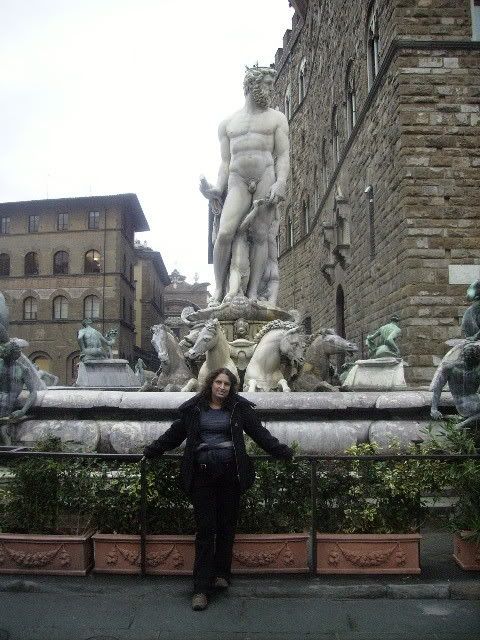
Next to it is copy of Donatello's Judith and Holophernes
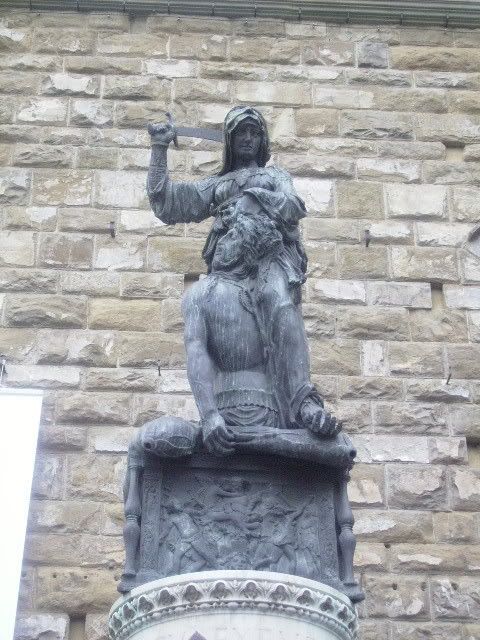
This is Shayne's favourite Renaissance subject - the calm demeanour of Judith as she decapitates the killer of her husband and oppressor of her people fascinated both of us. Later we saw the real thing, but of course, no photo.
Adjacent to these two is the Loggia della Signoria, an roofed chamber sheltering some truly evocative sculptures:
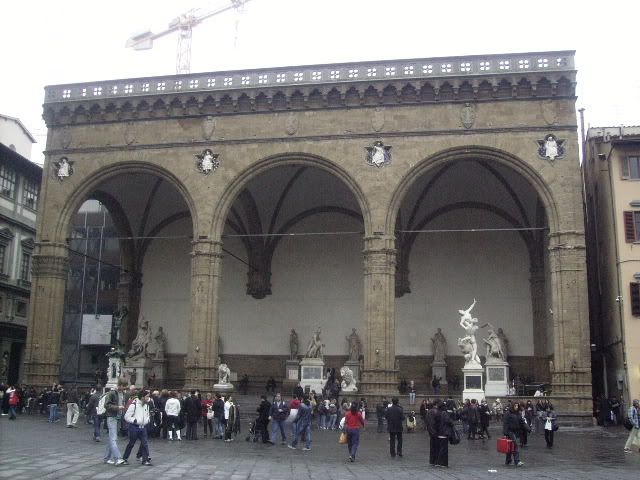
There's the two most famous ones, Cellini's Perseus:

Unforgettable not only for the detail of the Medusa's spinal column and associated gore, but for the relief work at the base.
Also, Giambologna's Rape of the Sabines:
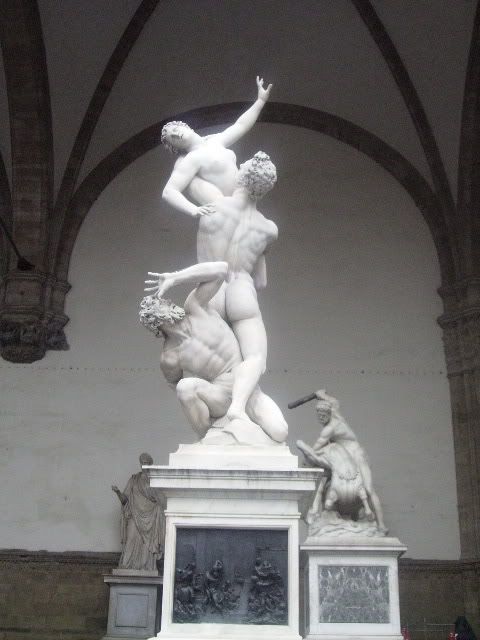
It is truly a beautiful and disturbing piece. However, in our opinion, there is a better sculpture dealing with the same topic, which we think is called Abduction of Polixena:
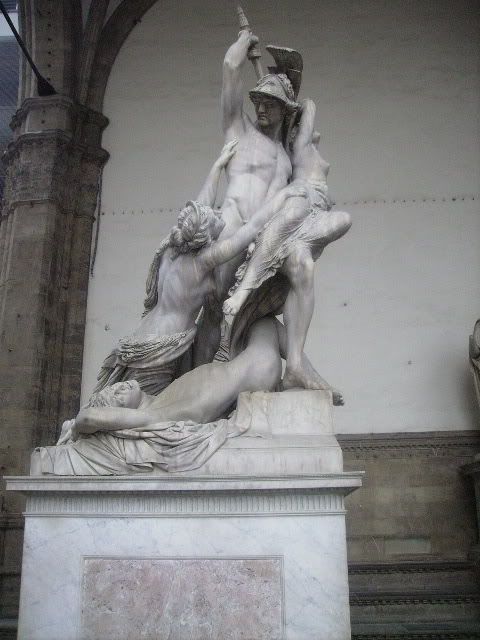
We love this one not just for the emotion it captures, but for the exquisite detail and the seeming fluidity of the marble, almost as if it's in motion.
The second place was the Pallazo Vecchio (sorry for the darkness of the shot):
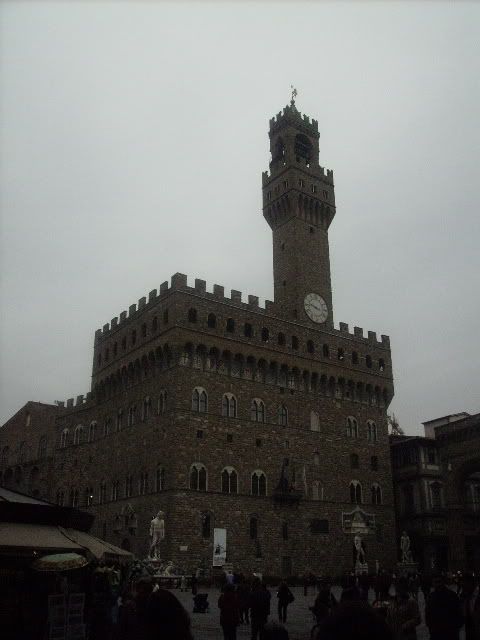
It is at the edge of the Piazza, and was used as the headquarters of the Medicis, and the rather plain exterior hides a magnificent interior. There was a wing set up as rooms for one of the Medici wives, and the wing celebrated virtuous women, each room dedicated to a different woman from biblical, mythical or historical stories. For some reason, we got in half price here. We're still not sure how. We also managed to sneak a few more photos.
On the roof of one of the rooms, Penelope at her loom, ignoring her suitors and being faithful to Odysseus as he gallivanted around the globe:
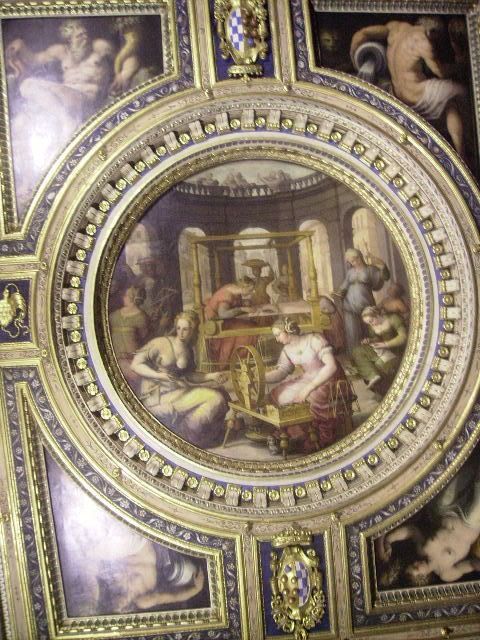
Dante's death mask. Very very cool.
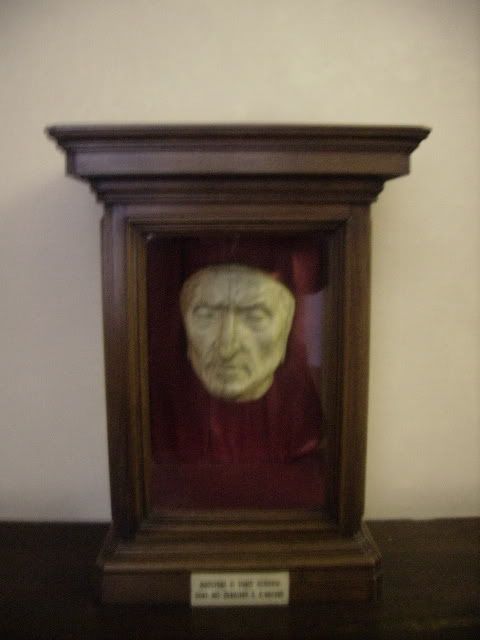
Also in the Vecchio, we saw the original Judith and Holophernes, and a Map Room (which Eva added to her list of things she wants in our house, along with the African honey badger, elephant, and Gaudi mosaic sculpture. Ahem). The Vecchio was definitely the highlight of Florence. Well, except for the night we walked up to Piazzale Michelangelo and saw the Florentian cityscape by night:

We haven't mentioned our fellow hostel dwellers! The hostel we stayed at was tiny, and therefore you couldn't help but meet people. There were two young Aussie girls, Anthea and Emma from Sydney, and an American called Jon (full name Jonathan Davis. Yes, there were many Korn jokes!), and we immediately got on like a house on fire. We went out for dinner and drinks one night, and there was a bit too much cheap Italian house wine involved:
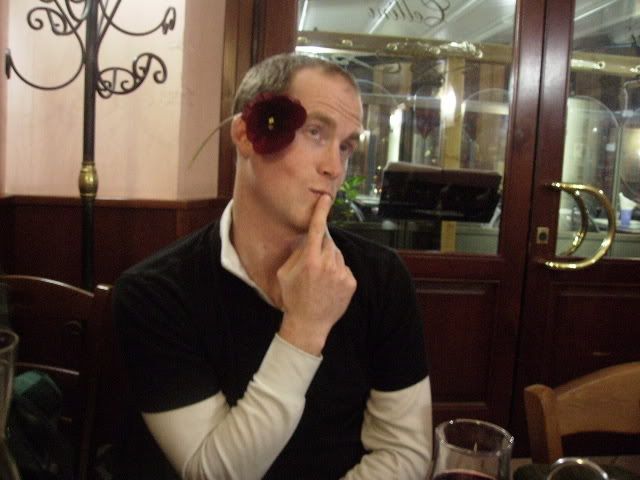
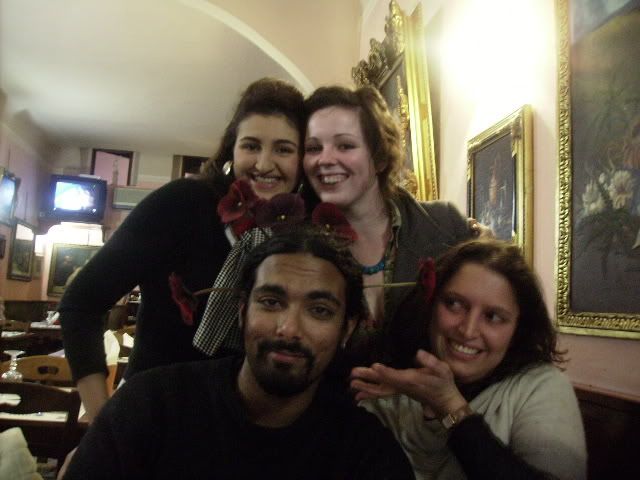
Shayne has a feeling he will regret that photo.
We went for a trip into the Tuscan hills with Jon for a day, into a little town called Montalcino. The setting was picturesque, if a bit chilly What happened to that Mediterranean warmth, huh??
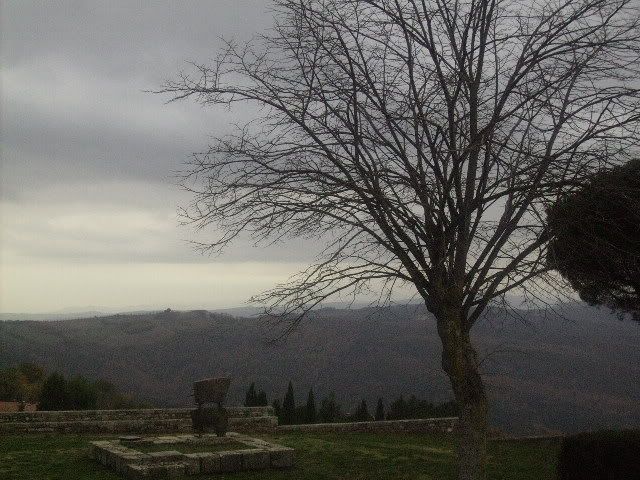
Jon was there to try some Brunello, the famous wine from that region.
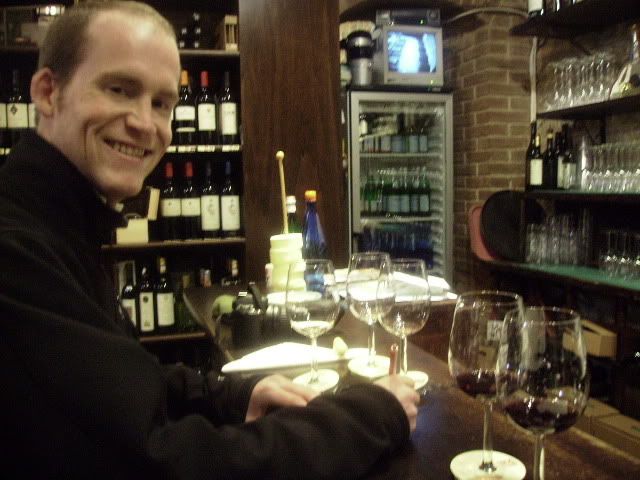
It cost him 19 euros to taste five wines. It was worth it for him because he's a connoisseur, who took notes, sniffed, swirled, and carefully examined the tint of the wine before enjoying it. Shayne's a lot less sophisticated, and bought one glass of the cheaper vintage. And then almost had a heart attack at the price of a bottle:
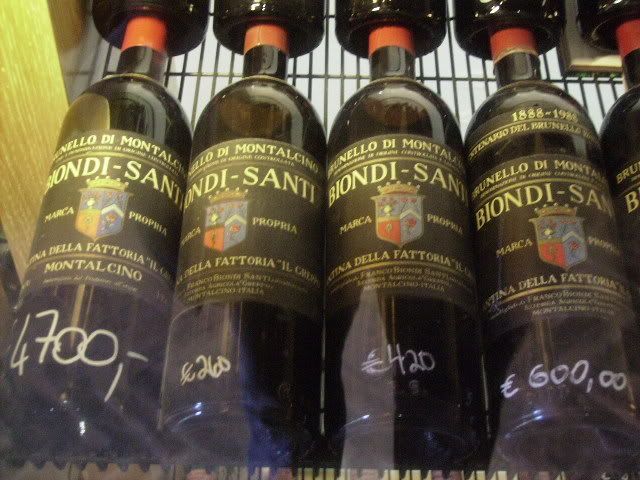
Yeah. He'll stick to inexpensive Aussie red, thank you very much.
The place we had the wine was this fortress at the top of the hill overlooking the town:
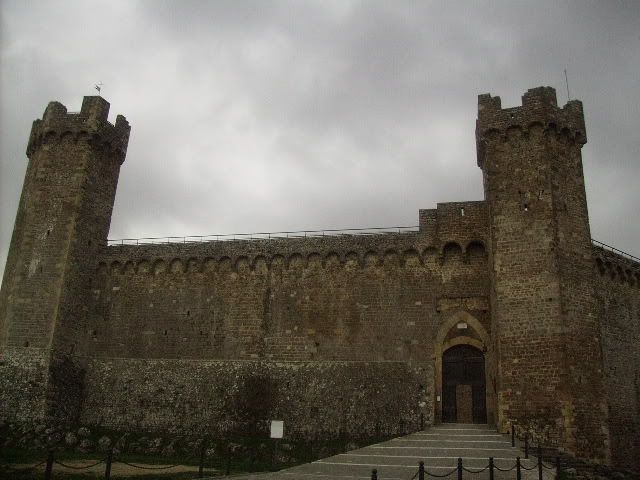
And on the grounds, overlooking the hills, we celebrated Thanksgiving with Jon, a very simple yet satisfying meal of bread, local salami, pecorino cheese, mandarins, and the cheapest bottle of wine we could buy:
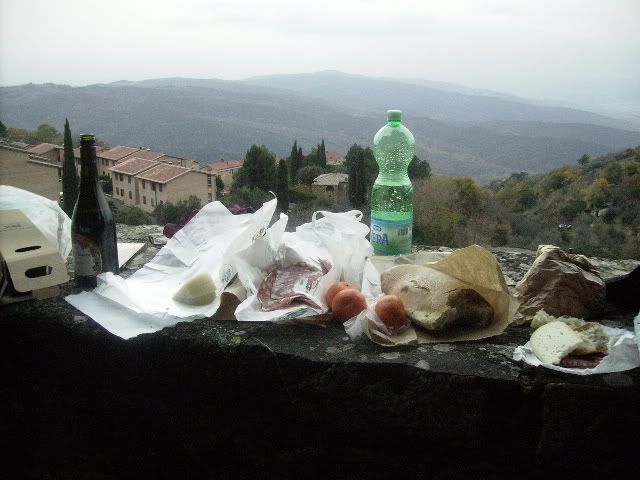
After five days in Italy, we boarded another overnight train to Vienna. After an almost sleepless night for Shayne, thanks to the moronic conductors who kept on barging into our compartment at all hours asking for tickets, we arrived early in the morning and boarded another train to
Prague
Before we got there, however, we met one of the strangest characters we've ever come across.
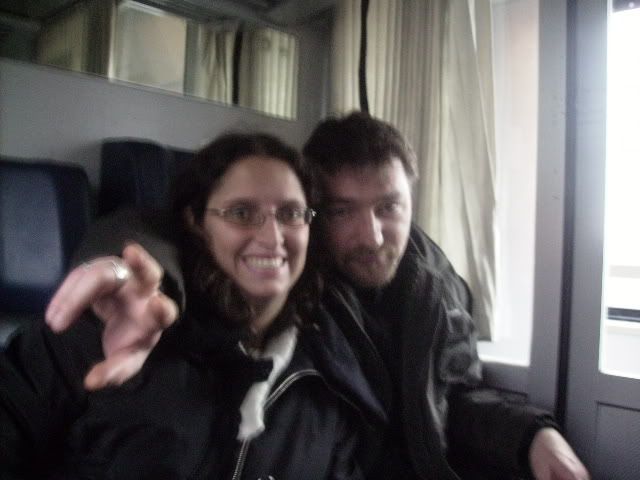
We think his name was Jan (pronounced "Hans"). He was Slovakian, and spoke no English (except for the swear words), and we managed to painfully communicate with him in our mutual terrible German. With this in our arsenal, we got his story - he's a Slovak working in the Czech republic, supporting a young family, he hates Czechs but knows that the money is there rather than in Slovakia ("Für Geld, Czech ist gut, Slovak ist schlecht!"). He lost some of that Geld when he was caught by a conductor smoking in the toilet - he came back to the compartment sheepishly, demonstrating that he'd just paid a bribe of about 100 Czech korunys to her (about $AUD6, but still...). Later, the police came through and sniffed around in the compartment, while he sat there with an innocent look on his face. He also picked up the phrase "shuddup!" from Shayne when Shayne jokingly told Eva to do so - for the rest of the trip he'd intermittently yell out "SHUDDUP!" He got off in Prague with us, still telling random people to "SHUDDUP!" and hugged us both goodbye. One of the more bizzare people we've met...
Eva's dad kindly paid for our three nights in Prague, because his longtime friend Marina, who lived with the family in London and looked after Katie and Eva when they both had whooping cough, lives in Prague, and he wanted to make sure that we were close to her. She very close to the historical, beautiful centre of Prague, and on the second day we were there, she met up with us and took us out to a typical Czech restaurant, where we had some of the richest, best food we've had in a long time.

During the day proceeding that food and fun-filled night, we ventured out to Czech out (oooh! Pun fun!) the city. The first hotel we were in was very close to Václavské náměstí (Wenceslas Square), the main street of so-called "New Prague", which is still bloody ancient (dating back to the 14th century). At the top is the Czech national Museum (which we didn't visit, as we'd had enough of museums by now!)
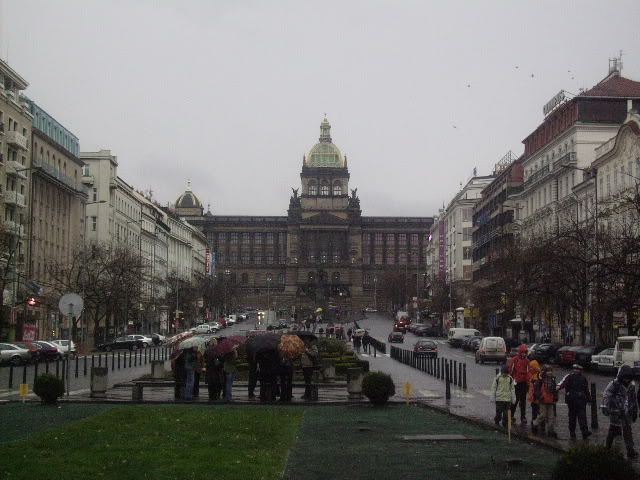
From here we made our way into the Old Town, parts of which date back to the 11th century. It was in the middle of this little walk that Eva realised she might get a little cold in a skirt, stockings and Mary Janes. Especially when it started snowing.
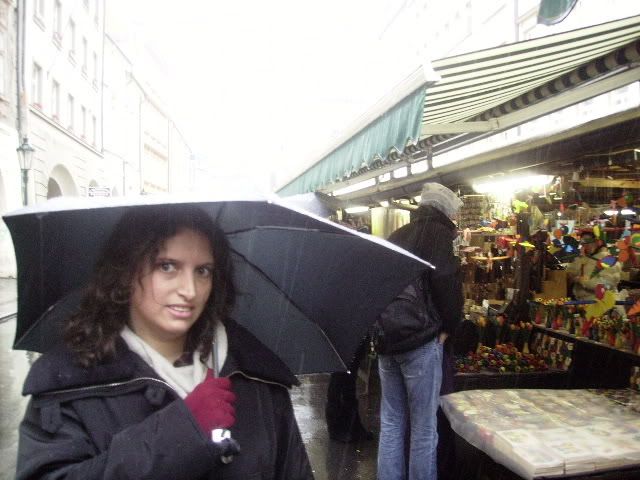
Similarly, Shayne had to eventually concede that his umbrella just wasn't up to the task of a Prague winter. This took much persuasion on Eva's part, but he saw the light:
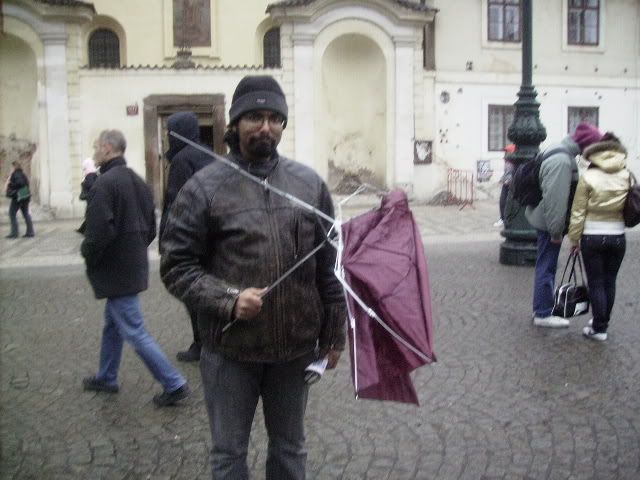
So, while freezing our backsides off, we walked some of the most fairytale-like streets we've ever seen. Here are some highlights:
Powder Tower
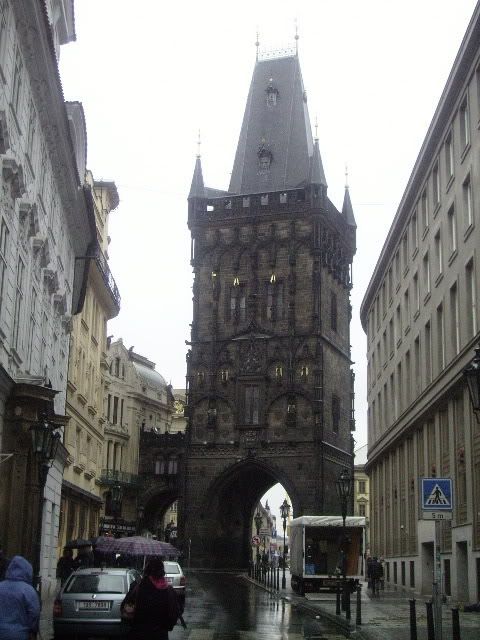
Built in the 13th century as an entrance to the Old Town, it was also used to store gunpowder in the 17th century, thus the name.
The Old Town Square
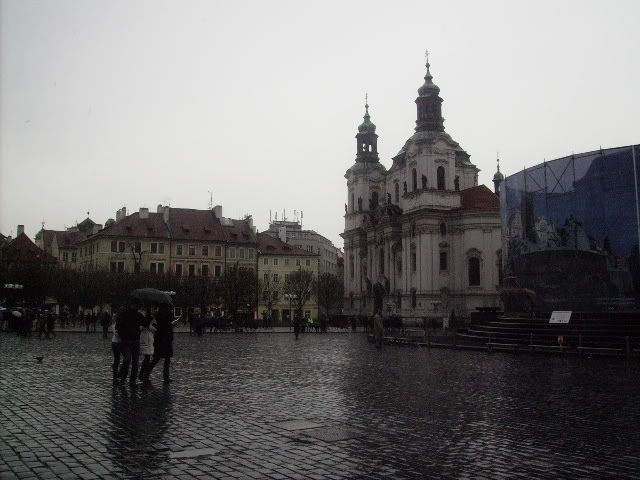
Unfortunately the Jan Hus Monument, a monument to Czech hero and reformist preacher Jan Hus, is hidden behind scaffolding and ads. However, you can see the Church of St. Nicholas, built in 18th century.
City Hall
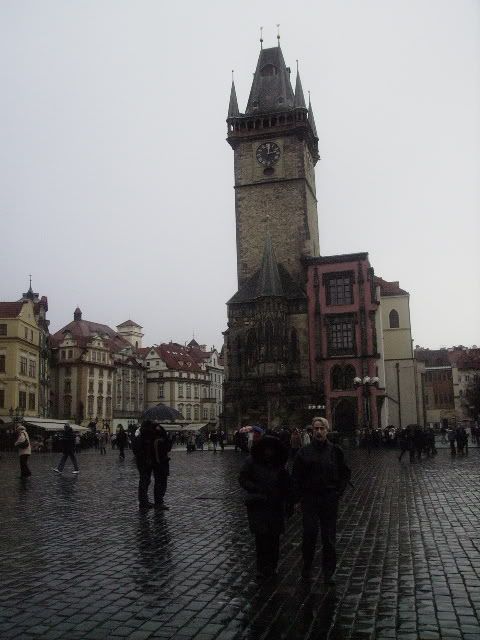
This was set up in 1338 by combining several Renaissance and Gothic houses together, and was constructed after 1945 when it was badly damaged by the Nazis. It also houses the Astronomical Clock, which has been functioning since 1572:
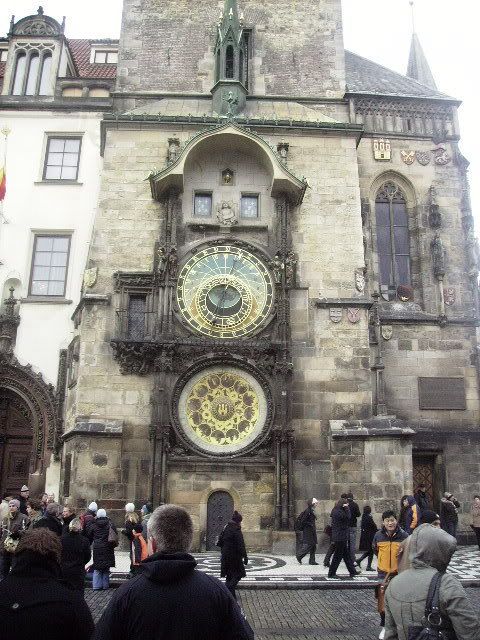
And every hour, people crowd around the bottom to see one of the most anti-climactic markings of the hour since Big Ben. This is all according to Shayne, of course. Basically, when the clock goes off, the twelve Apostles can be seen in a procession through two open windows, and Death ringing a bell.
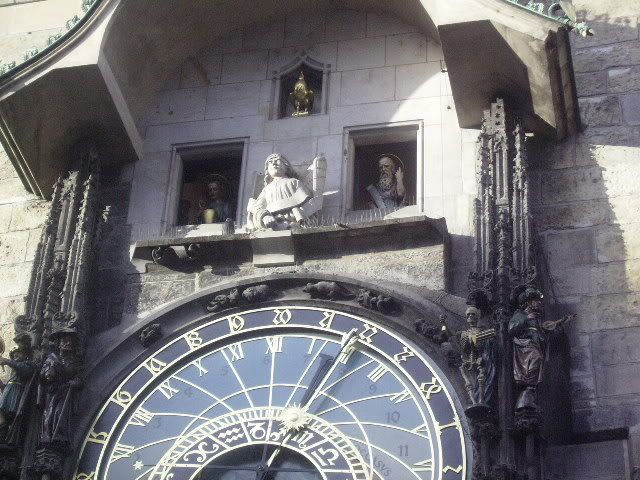
The chiming of the clock interrupted the far superior stylings of the old guys playing bluegrass in the middle of the square.
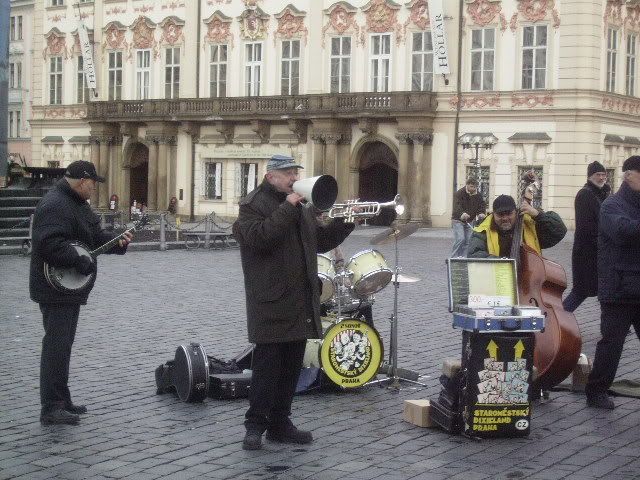
There's nothing like hearing "Bye Bye Blackbird" through a megaphone, in a gravelly, slivovitz-and-cigarette decimated voice. A backdrop for their performance was the spectacular gothic 14th century Church of Our Lady Before Tyn
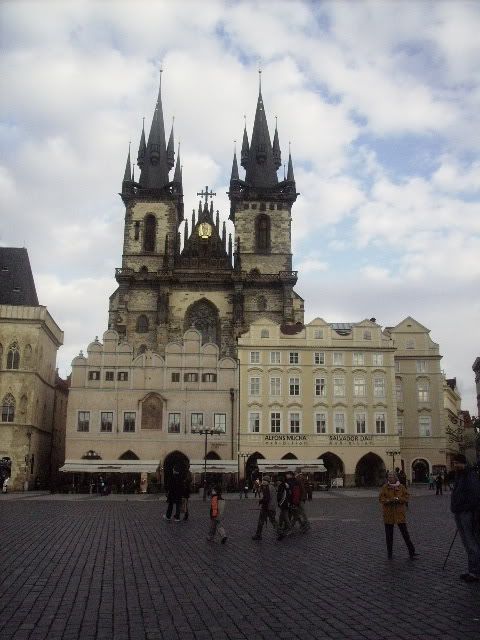
Moving into the Jewish Quarter, we saw a few interesting synagogues, including the Klausen Synagogue:
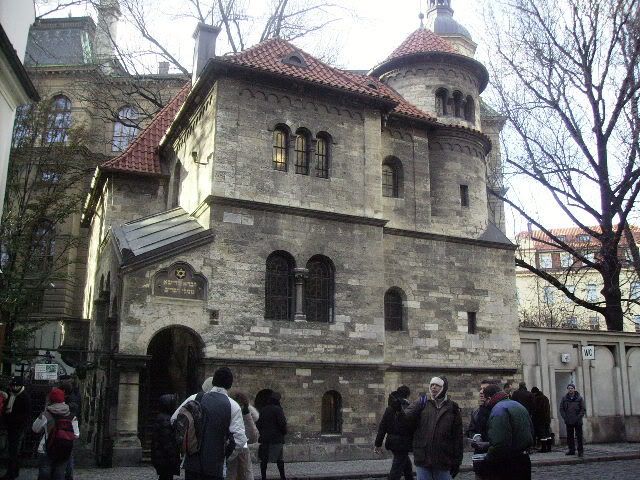
which has the Old Jewish Cemetery within its grounds, dating back to 1478. Apparently, due to limited space, the dead had to be buried on top of each other, up to twelve deep in some cases. It sounded pretty cool, but we weren't about to spend the equivalent of $AUD15 to go into it.
Across the road was the Old New Synagogue:
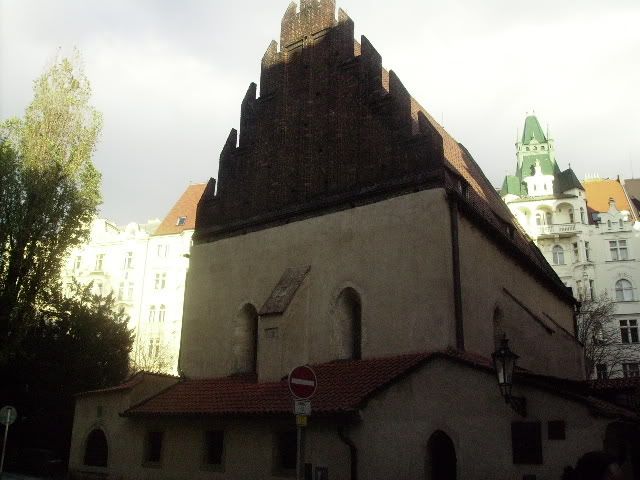
which is the oldest synagogue in Europe that's still in use, having been completed in 1270. It's survived pretty much everything that was thrown at the Jewish people: pogroms, fires, you name it. Apparently there are still bloodstains inside on the walls that can't be washed off. However, we couldn't tell you for certain because, again, we were too stingy to pay the entry fee. In our defense, Marina did agree with us that it was ridiculous for them to charge so much to see some of Prague's places of worship, if at all.
The next day, we visited another historical part of Prague, the Castle and Lesser Town, which is over the river Vltava. We got there by crossing Prague's most famous bridge, the Charles Bridge, both ends of which boast these impressive entrance gates:
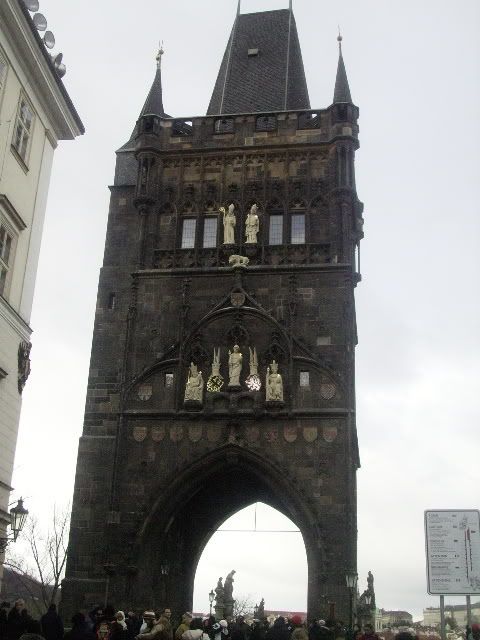
and is lined with statues, one of the most eye-catching being this one at the end:
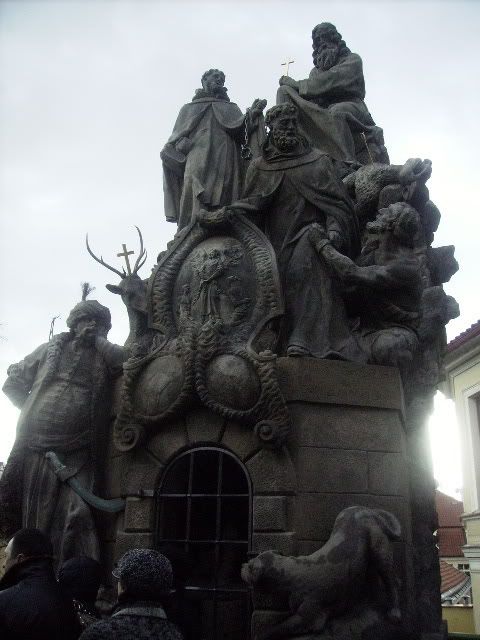
You can't see it, but behind the caged section of the statue are some stone prisoners in shackles, reaching out and imploring the passerby to set them free. It's disturbing to say the least.
Once we got off the bridge and into Lesser Town, we were again surrounded by astonishingly beautiful, fairytale-like buildings, flanking steeply-curving roads leading up to the castle, of which you can see the cathedral in the skyline.
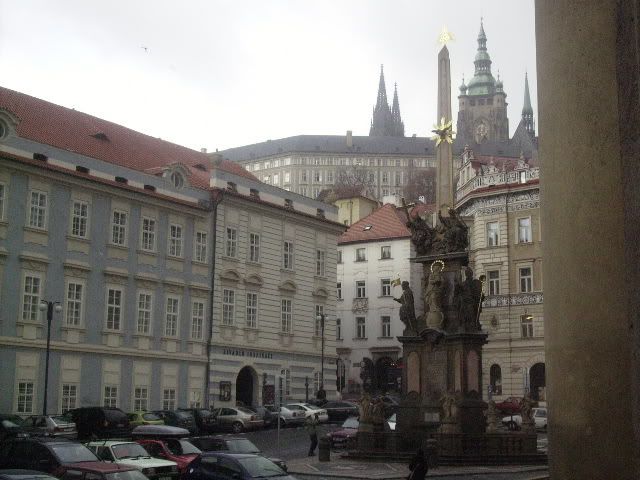
We climbed the many stairs that led up to the castle grounds. There are actually a few buildings that make up what is known as "the castle", but the most striking is St. Vitus Cathedral. Once again, a gothic building, it soars above the surrounding buildings.
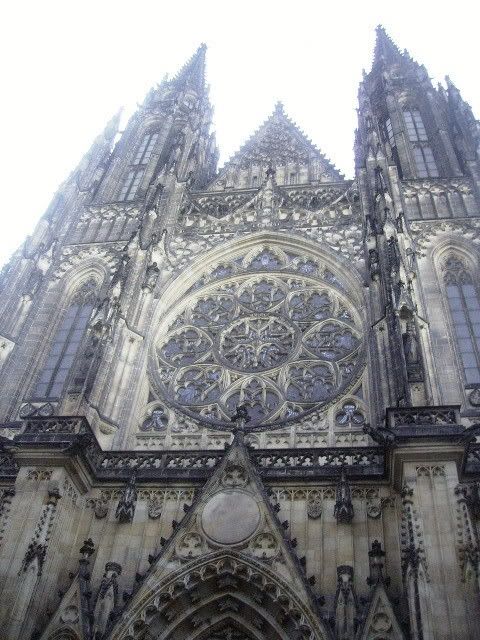
An interesting thing about the gargoyles on this church (and we have seen a fair few gargoyles in our travels!) is that they appear to be more humanoid than most, especially this little guy here:
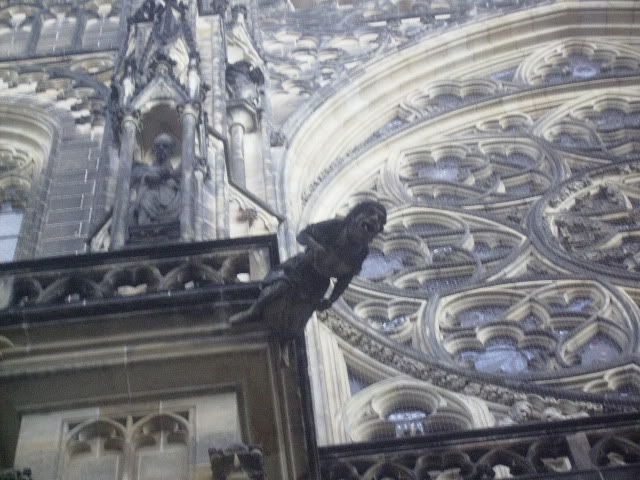
The inside was also more impressive than most grand old cathedrals in Europe that we've seen, including Mont Saint-Michel, and certainly rivaling Notre-Dame. What was especially fascinating were some of the statues, including this one, which appears to be the Heavenly Father grieving over the Crucified Jesus...then again, we're no theologians...
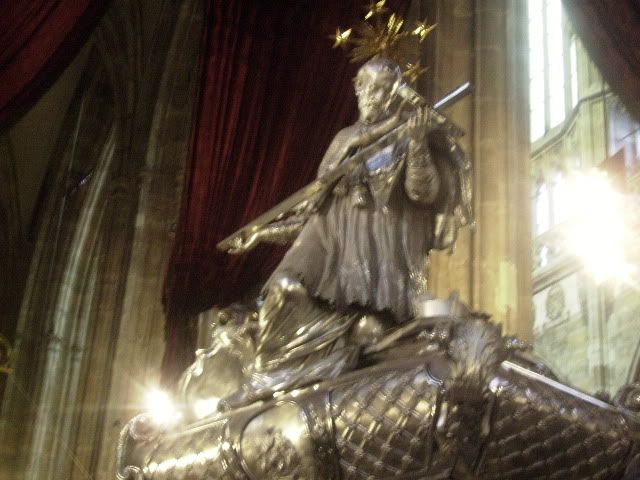
And a view of one of the chapels:
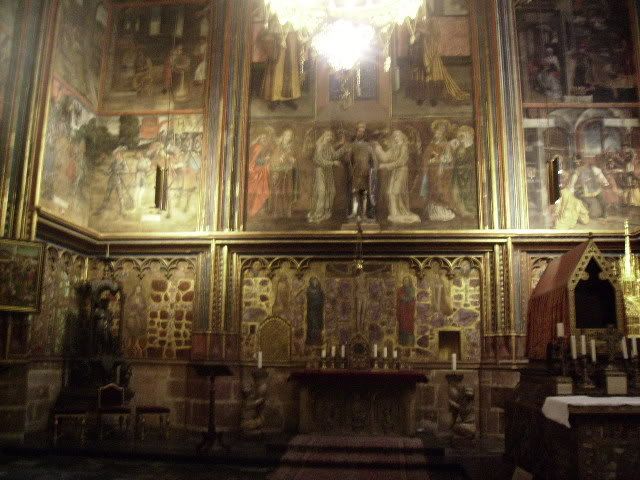
We then made our way to the stairs to the belltower. This was one of the most gruelling, frightening climbs we've had on this trip. Yes, including the incredibly arduous one up Pacaya in Guatemala. Thinks a cramped, steep, badly-lit, extremely-crowded spiralling staircase with no bannister. Oh, we forgot - imagine two-way traffic in a space only designed for one-way traffic. Then imagine over 270 stairs. Yeah...all the way up, we were both thinking, "This had better be worth it."
It was...it had been snowing all the time we were climbing, so while it was absolutely freezing, it was also absolutely stunning. Looking out through the open portals at the flakes falling into the courtyard below, it was kind of like being in a snowdome:
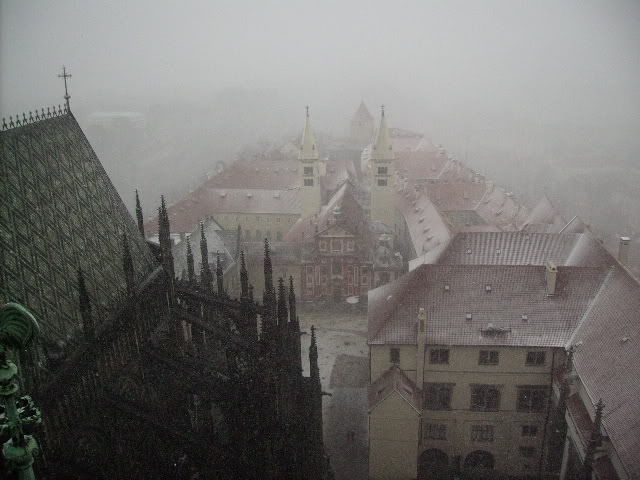
When we got down, we went a little crazy about the fact that it was snowing. It must have been obvious that we were from the Southern Hemisphere, as we started taking photos for the snow rather than for what it was falling upon:
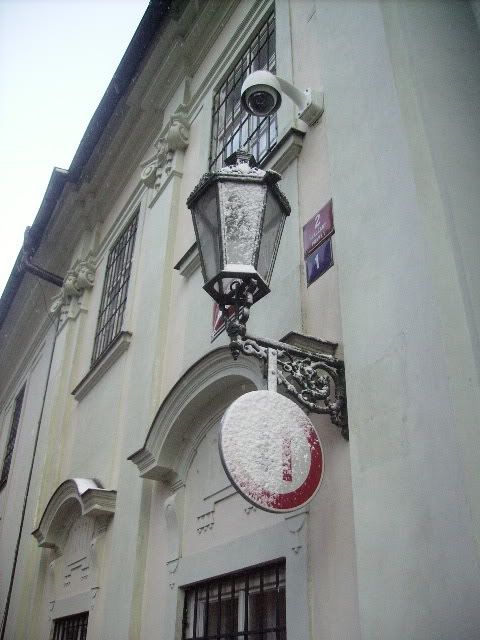
When we were walking back down to Lesser Town, the sun came out and shone on the snow-capped town:
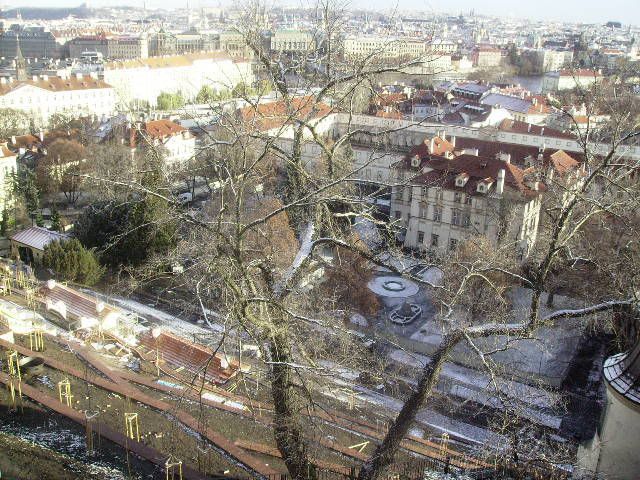
What little we saw of Prague enchanted us, and we (in what is becoming a "broken record" statement), we hope to back and explore it more fully. A couple of slightly odd features of this city (that are probably common to other areas of the Czech Republic) are its Communist-era trams:
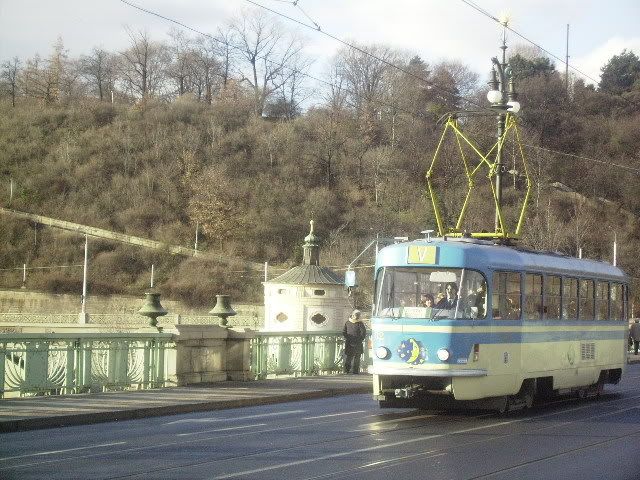
Some of which have obviously been refurbished, like the one above (they're usually red and white)...
...and the ridiculously tiny WCs.
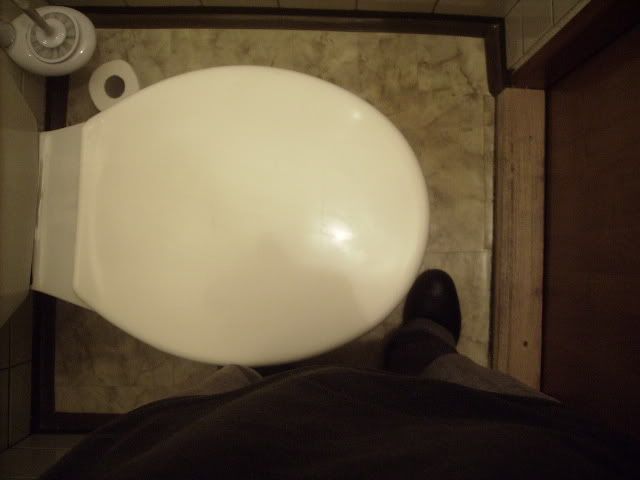
When your knees are touching the door, you know that it's too damn small!
We're on the home stretch for this post now...next we made our way to:
Berlin
We only spent a day and two nights here first time 'round, our trip shortened by the aforementioned rail strike. We had hooked up a Couchsurfing host, Gesa, pictured here in the foreground making dinner:
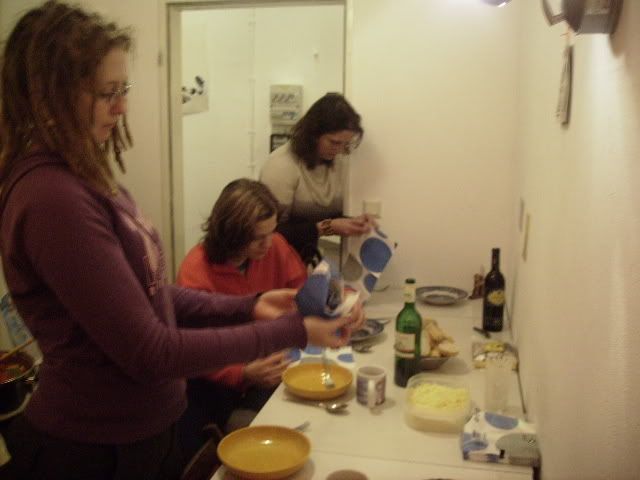
flanked by another Couchsurfer she was hosting, Amelie from Quebec, and that weird girl who keeps popping up in our photos. Maybe she's a ghost...
Gesa was studying while we were there (she's doing the coolest course EVER. She's studying pyrotechnics. Yes, she plays with FIREWORKS!!), so she was very busy when we were there and we didn't see much of her. However, the first night she took us
out to a Couchsurfing gathering/meeting in a pub for people in her area, and here we met Andreas, who was fated to become our next Couchsurfing host. More on him later...
For the day that we were here, we basically piggybacked on Amelie's already-planned sight-seeing schedule, which included:
The East Side Gallery
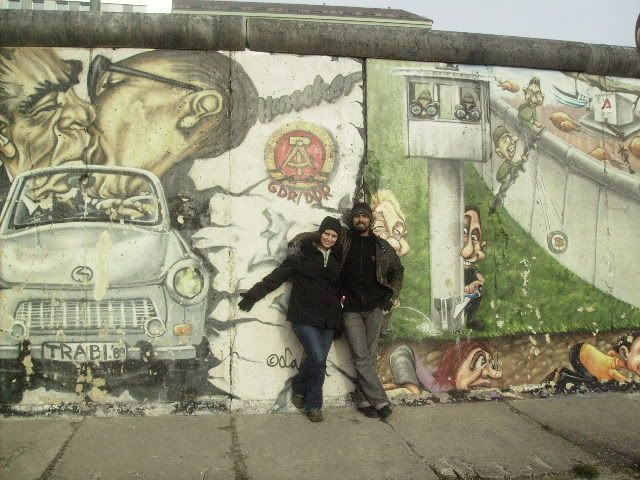
This part of the Berlin Wall that still stands was largely decorated after the wall fell down (especially on the eastern side where you couldn't get within 10 metres of the fence without being shot at, mauled by dogs, or sliced by razor wire), and some of the paintings and graffiti are quite haunting.
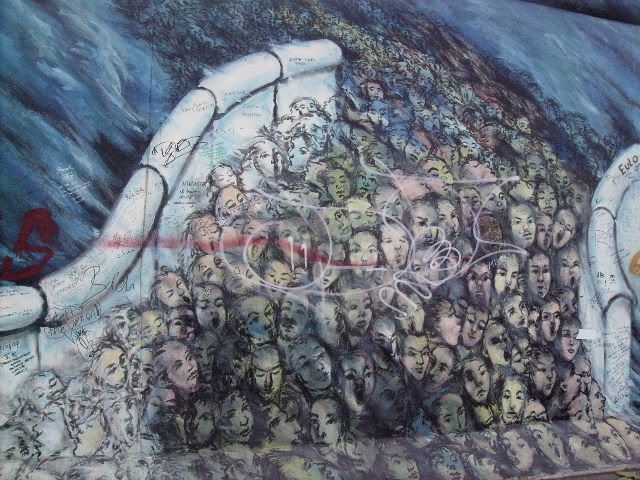
...while some are just plain ridiculous:
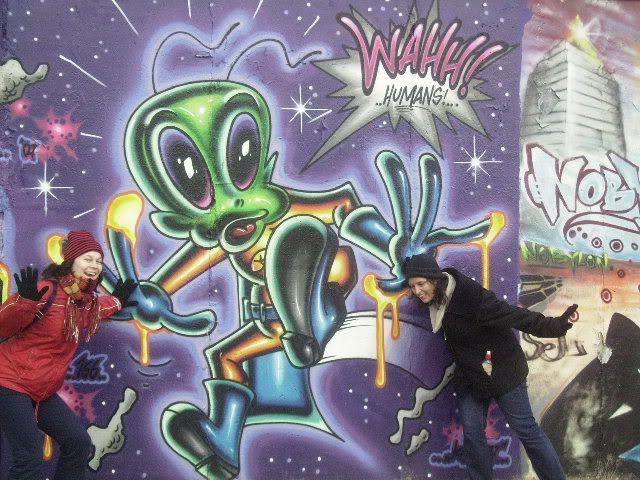
This part of the wall stretches for at least a kilometre. Most of it has since been torn down - understandably, as it was such a stark reminder of thirty years of repression and totalitarianism.
Another reminder of the Communist regime and the strangeness of this until relatively recently divided city is
Checkpoint Charlie
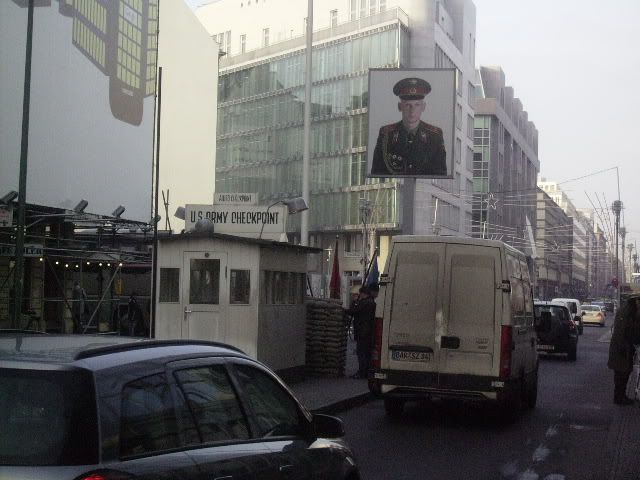
This was a famous border crossing between East and West Berlin - and therefore between the Communist states and the free world. It has apparently been mentioned in many espionage novels, along with a cafe on the corner (Cafe Adler) where spies from both sides used to hang out and spy on each other - and where we had lunch.
Holocaust Memorial
It got very dark very quickly, as it does in Europe in the winter. When we got to the controversial Holocaust memorial, which occupies a large area of central Berlin, the darkness provided quite an even more eerie feel to the site. Unlike most memorials, this is something you can experience rather than just observe. At the time we didn't really know what to make of it, but found it quite overwhelming and disorienting. When we came back to Berlin we found out more about it - but that's for another post.
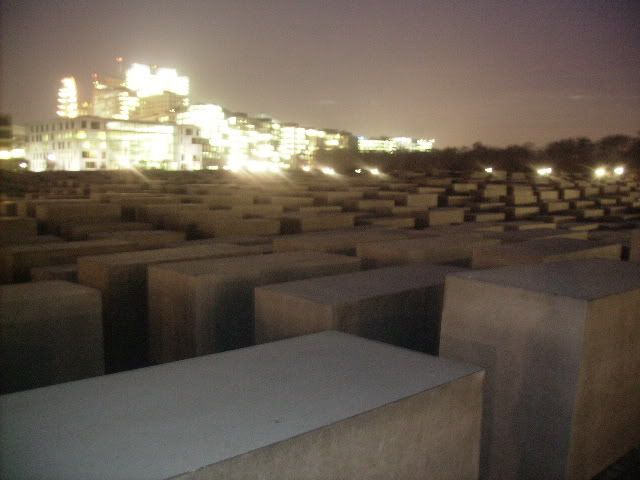
Close to the Holocaust memorial is a famous square:
Babelplatz
It is surrounded by Humboldt University and the Opera House where Hitler enjoyed a song or two. It's also the site where the Nazis burned 20,000 or so books by Jewish authors and other works deemed to be subversive or "degenerate". This is the site of another memorial, an interesting piece sunk into the ground and illuminated from below:
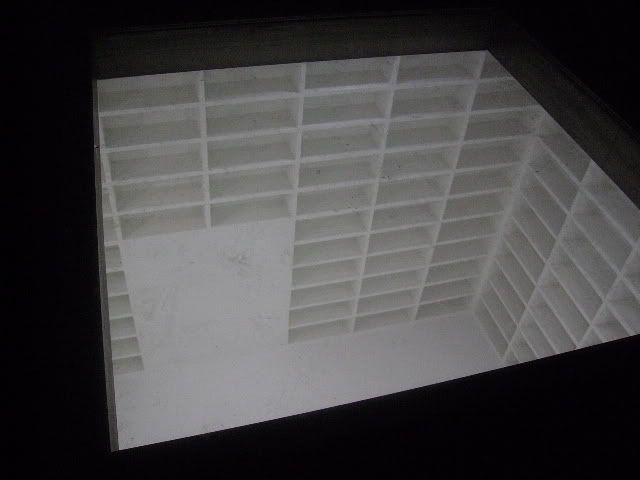
Somewhat incongruously, on the square that night was the opening of a temporary ice-skating rink plonked there for the winter. This occasion was marked by sexy ice skaters strutting (or sliding) their stuff:
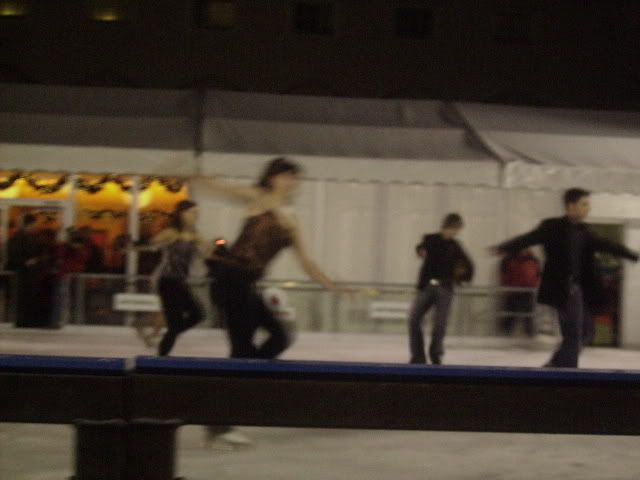
Shayne prayed there would be a big fall. He willed it. It didn't happen. Shayne was sad. Amelie and Eva were happy drinking glühwein or hot chocolate spiked with rum, dancing, and in Amelie's case, singing loudly to the soundtrack.
We realised that we had spent too little time in this city. We were fascinated by its history, and the obvious profound effect that the second world war and the thirty-year division had on its citizens. Shayne also had something else to return for:
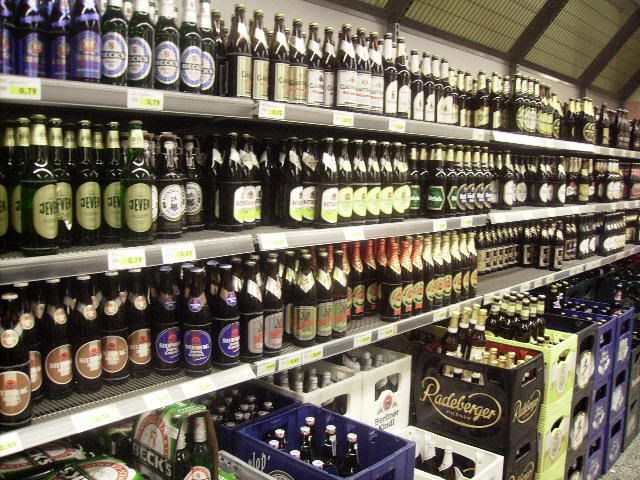
Next stop - Scandinavia, where we visited an old friend, visited Christmas markets, and where it was reaffirmed for us that the Australian dollar really does suck.
